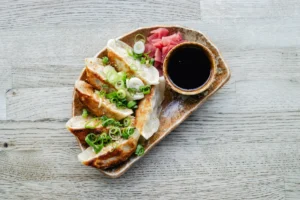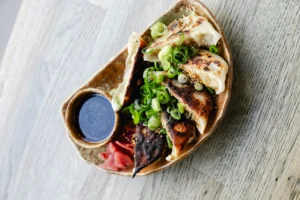Japanese Fine Dining: The Art of Kaiseki
Japanese fine dining comes alive through Kaiseki, a seasonal multi-course experience that blends beauty, flavour, and cultural tradition. This multi-course experience combines artistry, tradition, and seasonal awareness. Every dish tells a story of balance and respect for nature. Unlike simple meals, Kaiseki reflects Japan’s philosophy of harmony and beauty in both taste and presentation.
What Makes Japanese Fine Dining Unique
 Kaiseki is more than food. It is an expression of Japanese culture. Each course arrives in a precise order, designed to engage the senses. Importantly, chefs follow the seasons closely. They choose ingredients that reflect the current climate. This approach ensures freshness and enhances connection to nature.
Kaiseki is more than food. It is an expression of Japanese culture. Each course arrives in a precise order, designed to engage the senses. Importantly, chefs follow the seasons closely. They choose ingredients that reflect the current climate. This approach ensures freshness and enhances connection to nature.
Moreover, Kaiseki highlights simplicity. Flavours remain subtle, allowing ingredients to shine. Presentation is equally important. Dishes arrive on carefully chosen plates, often matched to the time of year. Colours, shapes, and textures all work together to create visual harmony.
A Brief History of Kaiseki
Kaiseki began as a modest meal during tea ceremonies. In its early form, it focused on balance and lightness. Over time, however, it evolved into a sophisticated dining style. By the Edo period, Kaiseki had become associated with fine dining and refined culture.
Interestingly, two forms of Kaiseki exist today. One is linked to the tea ceremony. The other is the restaurant Kaiseki, known as Kaiseki-ryori. Both share an emphasis on seasonal awareness and mindful preparation. Yet restaurant Kaiseki often includes more courses and creative flair.
The Structure of Japanese Fine Dining
A full Kaiseki meal follows a clear structure. It usually begins with a light appetiser. After that, diners enjoy soup, sashimi, and several cooked dishes. Grilled, simmered, and steamed items appear in sequence. Rice, pickles, and miso soup arrive near the end. Finally, dessert closes the meal.
Although courses may vary, balance remains the guiding principle. No single flavour dominates. Instead, each dish complements the next. In this way, Kaiseki delivers variety while maintaining harmony.
The Role of Seasonality
Seasonality sits at the heart of Kaiseki. Chefs design menus around the changing months. For example, spring meals may highlight bamboo shoots or cherry blossoms. Autumn courses might feature mushrooms or chestnuts. Even the serving ware changes, with bowls or plates reflecting seasonal motifs.
This seasonal focus does more than please the eye. It also strengthens a cultural connection to nature. Diners feel the rhythm of the year through taste, colour, and aroma.
Aesthetic Principles in Kaiseki
Kaiseki is not just about eating. It is about experiencing beauty. Every element follows Japanese aesthetic values. The principles of wabi-sabi (simplicity and imperfection) often appear. So does shun, which celebrates peak-season ingredients.
Even the layout of the table plays a role. Space, colour contrast, and placement all matter. Chefs use these details to create balance between food, plate, and setting.
Kaiseki and Japanese Hospitality
Hospitality, or omotenashi, defines Kaiseki dining. Chefs and servers focus on anticipating guest needs. Every gesture, from serving order to table setting, reflects care and thoughtfulness.
Because of this, a Kaiseki meal feels personal. Diners experience not only flavours but also cultural warmth. This dedication to service helps explain Kaiseki’s reputation as haute cuisine.
Japanese Fine Dining in the Modern World
 Although deeply traditional, Kaiseki continues to evolve. Many chefs experiment with modern techniques. They blend classic courses with new styles, while still respecting seasonality and aesthetics. As a result, Kaiseki appeals to both Japanese diners and international visitors.
Although deeply traditional, Kaiseki continues to evolve. Many chefs experiment with modern techniques. They blend classic courses with new styles, while still respecting seasonality and aesthetics. As a result, Kaiseki appeals to both Japanese diners and international visitors.
Furthermore, luxury restaurants worldwide now feature Kaiseki-inspired menus. These modern interpretations keep the spirit alive while reaching new audiences. Yet the essence remains the same: harmony, beauty, and respect for nature.
Why Kaiseki Matters Today
Kaiseki teaches lessons beyond the dining table. It reminds people to value simplicity, patience, and mindfulness. In a fast-paced world, the slow, thoughtful rhythm of Kaiseki feels refreshing.
Additionally, it highlights sustainability. By using local, seasonal produce, chefs reduce waste and honour natural cycles. This approach makes Kaiseki not only beautiful but also responsible.
Experiencing Kaisediningki as a Visitor
For travellers to Japan, trying Kaiseki is a must. High-end restaurants, traditional inns, and even some tea houses offer it. Prices vary, but the experience always delivers cultural richness.
When dining, guests should expect a slow pace. Each course arrives with intention. Therefore, it is best to approach Kaiseki with patience and curiosity.
Final Thoughts
Kaiseki is the ultimate expression of Japanese haute cuisine. It blends history, hospitality, and aesthetics into a memorable dining experience. Through seasonal awareness and mindful preparation, it tells a story of harmony with nature.
In the end, Kaiseki offers more than food. It offers a journey into Japanese culture itself. Anyone seeking an authentic connection to Japan’s traditions will find it at the Kaiseki table.
